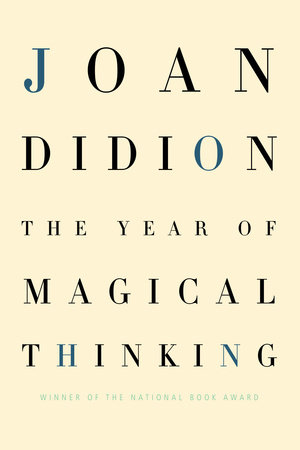The Year of Magical Thinking Reader’s Guide
By Joan Didion


1. Consider the four sentences in italics that begin chapter one. What did you think when you read them for the first time? What do you think now?
2. In particular, address “The question of self-pity.” [p. 3]. Does Didion pity herself? In what ways does she indulge that impulse, and in what ways does she deny it?
3. Read the Judges’ Citation for the National Book Award, below. Why do you suppose they deemed the book a masterpiece of investigative journalism?
“The Year of Magical Thinking is a masterpiece in two genres: memoir and investigative journalism. The subject of the memoir is the year after the sudden death of the writer’s husband. The target of the investigation, though, is the nature of folly and time. The writer attends to details, assembles a chronology, and asks hard questions of the
witnesses, most notably herself. But she imagines that the story she tells can be revised, the world righted, her husband returned, alive. What she offers is an unflinching journey into intimacy and grief.”
—The Judges Citation for the 2005 National Book Award for Nonfiction
4. Discuss the notion of “magical thinking.” Have you ever experienced anything like this, after a loss or some other life-changing occurrence? How did it help, or hinder, your healing?
5. Do you think Didion’s “year of magical thinking” ended after one year, or did it likely continue?
6. Consider the tone Didion uses throughout the book, one of relatively cool detachment. Clearly she is in mourning, and yet her anguish is quite muted. How did this detached tone affect your reading experience?
7. How does Didion use humor? To express her grief, to deflect it, or for another purpose entirely?
8. Over the course of the book, Didion excerpts a variety of poems. Which resonated for you most deeply, and why?
9. To Didion, there is a clear distinction between grief and mourning. What differences do you see between the two?
10. One word critics have used again and again in describing this book is “exhilarating.” Did you find it to be so? Why, or why not?
11. Discuss Didion’s repetition of sentences like “For once in your life just let it go” [pp. 141,174]; “We call it the widowmaker” [pp. 157, 203, 207]; “I tell you that I shall not live two days” [pp. 26, 80, 112, 153, 207]; and “Life changes in the instant.” [pp. 3, 77, 89]. What purpose does the repetition serve? How did your understanding of her grief change each time you reread one of these sentences?
12. The lifestyle described in this book is quite different from the way most people live, with glamorous friends, expensive homes, and trips to Hawaii, Paris, South America, etc., and yet none of that spared Didion from experiencing profound grief. Did her seemingly privileged life color your feelings about the book at all? Did that change after reading it?
13. At several points in the book Didion describes her need for knowledge, whether it’s from reading medical journals or grilling the doctors at her daughter’s bedside. How do you think this helped her to cope?
14. Reread the “gilded-boy story” on pages 105–6. How would you answer the questions it raised for Didion?
15. Is there a turning point in this book? If so, where would you place it and why?
16. The last sentence of the book is “No eye is on the sparrow but he did tell me that.” What does this mean?
17. Didion has adapted The Year of Magical Thinking into a Broadway play. How do you imagine its transition from page to stage? Would you want to see the play?
18. Before The Year of Magical Thinking, had you ever read any of Joan Didion’s work? Do you see any similar themes or motifs?
Just for joining you’ll get personalized recommendations on your dashboard daily and features only for members.
Find Out More Join Now Sign In